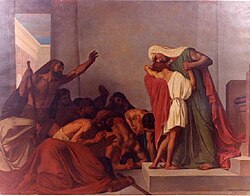Foreshadowing is a narrative device in which suggestions or warnings about events to come are dropped or planted. Foreshadowing often appears at the beginning of a story, and it helps develop or subvert the audience's expectations about upcoming events. [1] [2]
Contents
A writer may implement foreshadowing in many different ways such as character dialogues, plot events, and changes in setting. Even the title of a work or a chapter can act as a clue that suggests what is going to happen. Foreshadowing in fiction creates an atmosphere of suspense in a story so that the readers are interested and want to know more.
The literary device is generally used to build anticipation in the minds of readers about what might happen next to add dramatic tension to a story. Moreover, foreshadowing can make extraordinary and bizarre events appear credible, and some events are predicted so that the audience feels that it anticipated them. [3]
Hints may be about future events, character revelations, and plot twists to create mood, convey theme, and build suspense, usually to hint at the good events that will likely cross paths with or happen to the main character later on. [4]
Plot can be delayed by situations or events to give the impression that something momentous will occur to build anticipation and emphasize importance to them, which gives the audience a series of questions, particularly after cliffhangers.
The literary device is frequently adapted for use by composers of theatrical music, in the composition of operas, musicals, radio, films, television, gaming, podcasts, and internet scores and underscores, and incidental music for spoken theatrical productions.

